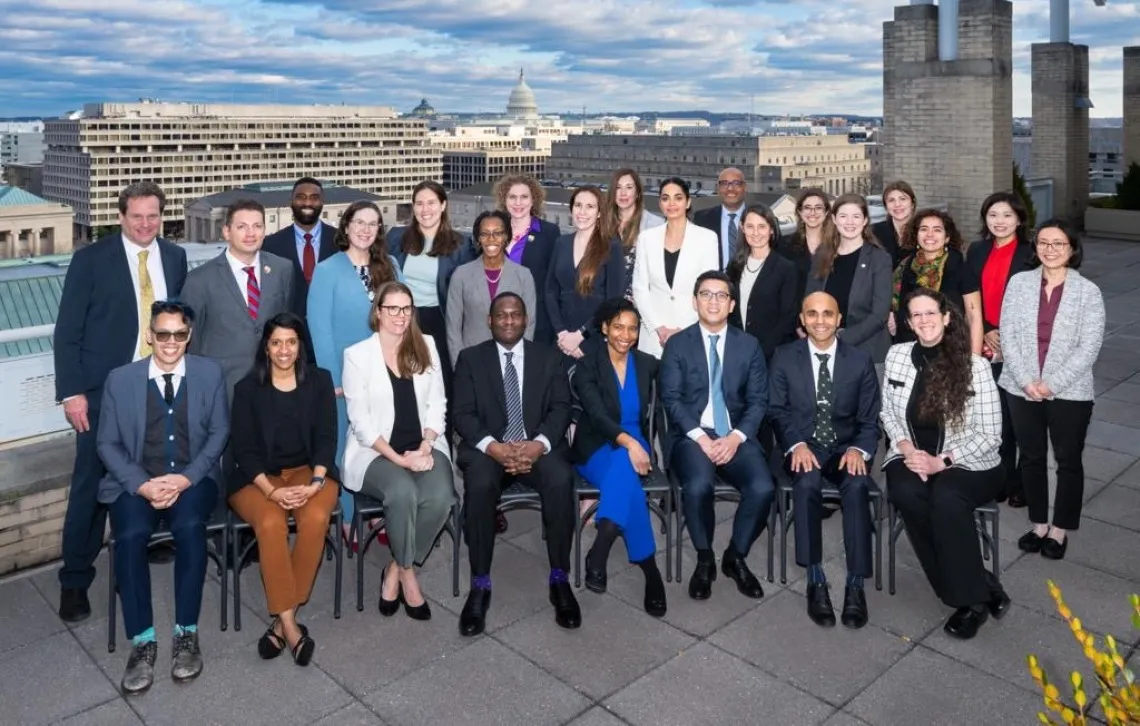Rachel Gallery Selected as New Voice in Sciences, Engineering, and Medicine

The 2024-2026 cohort of New Voices gathered for their inaugural meeting in Washington, D.C.
National Academies of Sciences, Engineering, and Medicine
The interdisciplinary cohort will work together for two years to address topics of pressing concern to the nation.
Rachel E. Gallery has been selected as a member of the 2024-2026 cohort of New Voices in the National Academies of Sciences, Engineering, and Medicine. Gallery will focus on facilitating connections and collaborations among researchers, students, practitioners, and policymakers around the world in biodiversity and conservation science.

Rachel E. Gallery
NASEM’s New Voices serve to expand the diversity of expertise engaged in the National Academies and build a network of emerging U.S. leaders in sciences, engineering, and medicine.
UArizona Regents Professor Emeritus of Neuroscience John G. Hildebrand, who is the international secretary of the National Academy of Sciences, helped to conceive the program.
“While most similar academies in other nations are primarily honorific, the National Academies are unique in having been created with a federal charter to advise the nation on matters of science and technology,” Hildebrand explained.
“I was very happy when someone at the University of Arizona was selected,” he said. “The New Voices program is incredibly competitive. It’s a real honor, and a true achievement reflected upon the university in keeping with its core mission.”
“I found the New Voices program particularly intriguing because of its emphasis on national-scale service,” said Gallery, who is director of the UArizona Lovejoy Center for Bridging Biodiversity, Conservation Science, and Policy within the Arizona Institute for Resilience and a professor in the School of Natural Resources and the Environment within the College of Agriculture, Life and Environmental Sciences.
“Through New Voices, Rachel Gallery has an opportunity to elevate our Institute’s work in developing sustainable and equitable solutions to environmental change to a national level,” said AIR Director Sharon Collinge. “And I can think of no one better to lead this larger effort.”
The National Academy of Sciences was established in 1863 by then-President Abraham Lincoln, with the National Academies of Engineering and Medicine established in later years.
All three are independent academies working on their own and together to advise the nation, convening experts to address pressing problems through studies, workshops, and roundtables. The thousands of publications they produce are freely available to anyone in the world.
“The big issues for us in the United States are not unique to us,” Hildebrand said. “They’re relevant for everyone, and that’s why we make our work available for anyone.”
NASEM’s New Voices is based on all three Academies and aims to elevate the perspectives, skills, and visions of rising and mid-career professionals.
“We’re bringing creative, smart, truly outstanding rising and mid-career people whose wisdom and enthusiasm are needed to augment the work that the Academies do to solve the world’s greatest challenges,” Hildebrand noted.
“One of our roles as New Voices is to use our networks to recommend our peers as participants in national studies and committees,” Gallery said. “I am genuinely excited about nominating my colleagues in service to my community.”
“And as director of the Lovejoy Center, I am especially excited about the opportunities I will have to connect through the New Voices program with the Inter-American Network of Academies of Sciences Amazon Initiative, which emphasizes science by and for the Amazon,” she added.
Each cohort selects focus areas for their two years of service. For 2024-2026, the group is considering topics such as improving U.S. life expectancy, combatting climate despair to inspire action, and increasing accessibility and translation of scientific assessments for large general audiences, among others.
“We have an emphasis on creating opportunities for people to thrive in interdisciplinary spaces,” Gallery said, “so that people with very diverse scientific and technical backgrounds can better work together to solve these important problems.”

From left, Sabrina Assoumou, Steffi Diem, Rachel Gallery, and Meghana Gadgil connected at the International Conference of Young Scientists.
Cable Risdon / Risdon Photography
One of the cohort’s important responsibilities was to cohost the 2024 International Conference of Young Scientists together with the Global Young Academy, an organization that mobilizes young scientific talent across the world to lead international, interdisciplinary initiatives to address global challenges. This international networking opportunity empowered the world’s emerging leaders in science to build inclusive collaboration networks aimed at co-creating a more sustainable global future.
Engaging with young scientists is already important work for Gallery as a professor of natural resources science. Through her interactions with the undergraduate students she teaches, Gallery hears how teenagers feel about issues such as climate change and environmental crises.
“These students will be the next generation of scientists, practitioners, and policymakers,” Gallery said. “I’m hearing their concerns firsthand. Through New Voices, I have an opportunity to elevate the perspectives of younger people who, even though they don’t yet have experience or expertise, still have an enormous stake in national and global decisions.”
UArizona’s mission is to “lead the way in developing adaptive problem-solvers capable of tackling our greatest challenges.” As a New Voice in Sciences, Engineering, and Medicine, Gallery will work with a diverse cohort from across the nation to do just that.

